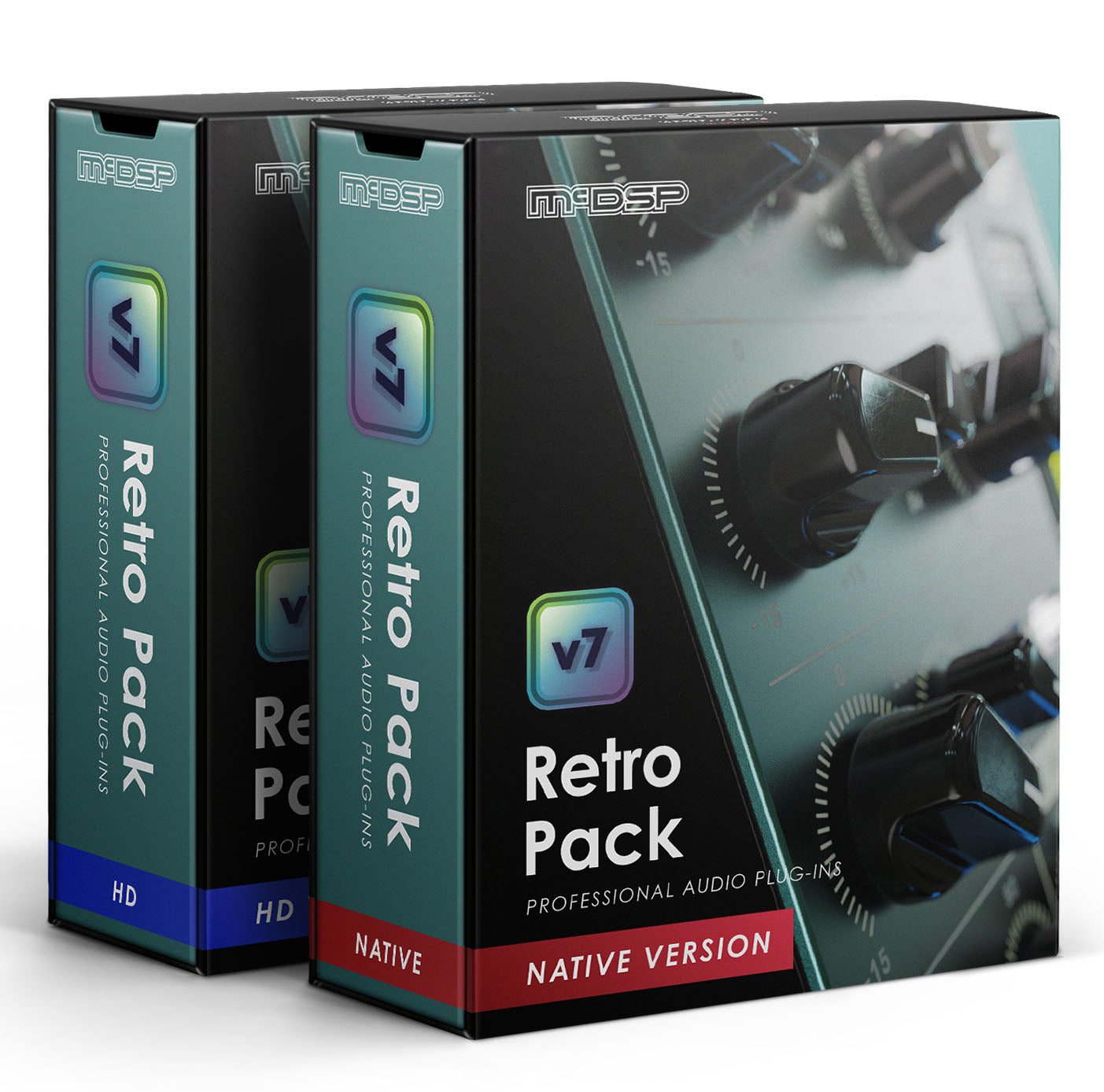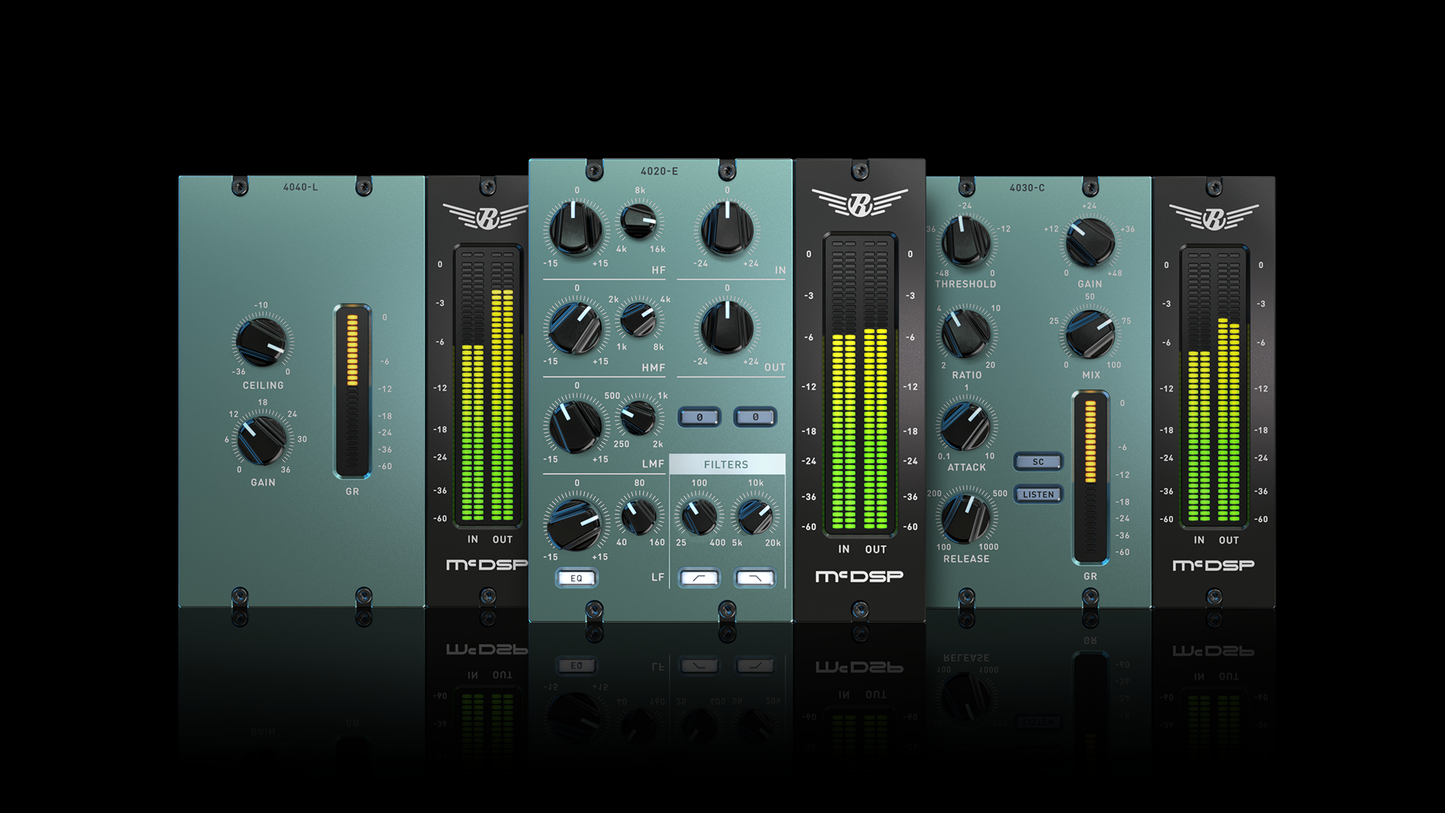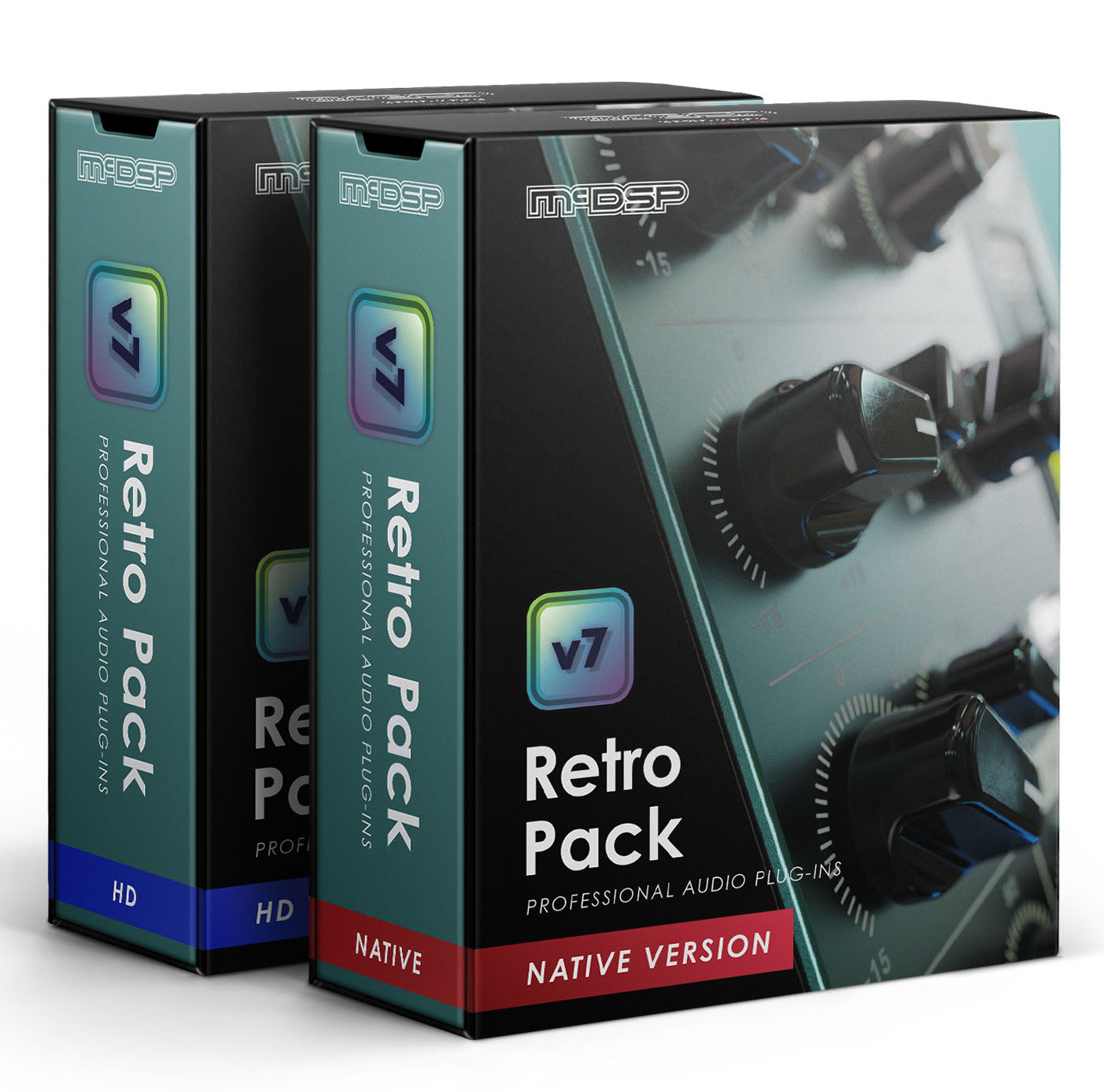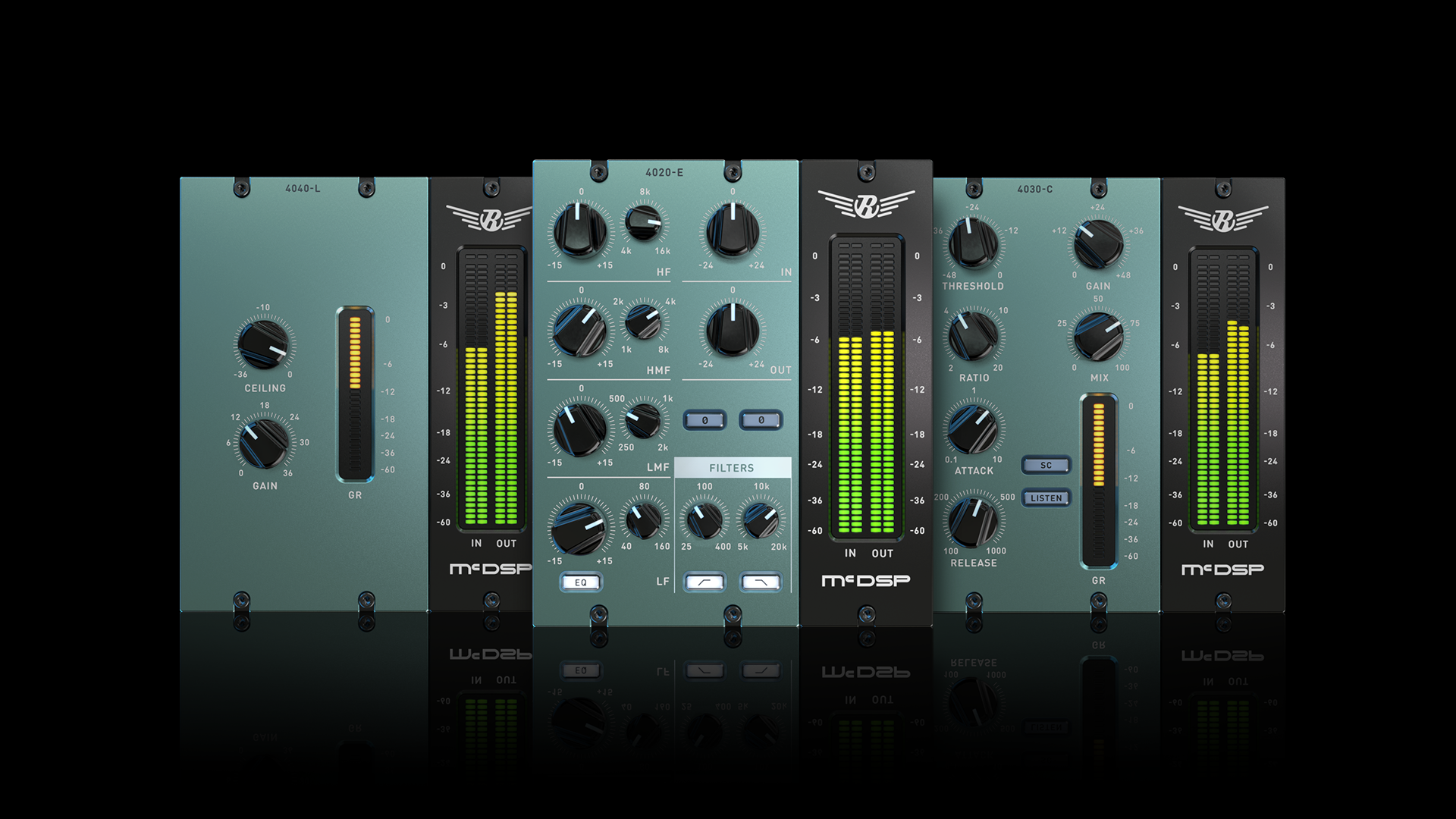

- Details
- Features
- Reviews
Retro plug-ins are designed for the ultimate vintage vibe, using new and original designs based on McDSP’s decade of industry experience. Retro plug-ins are a line of ‘classics’ that can live up to their own name without emulating something else.
- 4020 Retro EQ
- 4030 Retro Compressor
- 4040 Retro Limiter
All Retro plug-ins use a McDSP designed output stage topology to eliminate digital clipping at any output level and produce a smoother distortion characteristic. This feature is in addition to the analog saturation modeling that has made McDSP famous over the last decade.
Retro plug-ins are a line of ‘classics’ that can live up to their own name without emulating something else.
4020 Retro EQ
The 4020 Retro EQ is a 4 band EQ (LF shelf, LMF and HMF parametrics, HF shelf) with a high pass and low pass filter section. Ok boring right? Hold on audio dweeb.
Starting with the EQ section – the slope / Q of the shelving and parametric equalizers varies as gain is adjusted, in a manner unique to the 4020 Retro EQ. McDSP savvy customers might wonder if FilterBank, being the ‘Every EQ Ever Made’ plug-in, could duplicate the response curves of the 4020 Retro EQ. It might get close, but then those curves would have to be adjusted every time the EQ gain was updated. So think of the 4020 Retro EQ of having all those Peak-Slope-Dip and Q smarts under the hood, and then being able to adjust those parameters based on the user selected frequency and gain settings. Furthermore, the gain staging, EQ algorithm, and fabulous (hey this is my article) Anti-Clip circuit at the output stage are all new design elements not present in previous McDSP equalizer plug-ins.
Both the EQ and filter section frequency controls are calibrated in octaves (instead of decades) for a different twist on the audio effects when you twist those controls. The EQ section frequency ranges do not completely overlap, however they are designed for the optimum range their dynamic shape can cover in the audio spectrum.
The filter section uses a new design that varies the slope from a gradual 6 dB/Oct at the selected frequency to a maximum of 24 dB/Oct. As with the EQ section, the widely popular McDSP FilterBank plug-in could not match the varying slope response in the filter section of the 4020 Retro EQ.
4030 Retro Compressor
The 4030 Retro Compressor comes with the standard Threshold, Ratio, Attack and Release controls we’ve come to expect, but with a subtle variance. As the input signal is received, some smarts in the 4030 adjust these very parameters in real-time to minimize artifact generation (such distortion is caused by all compressors, analog or digital by the way). Furthermore the Mix control is awesome! Being able to balance the original (and highly transient) signal with the compressed version is so easy with the mix control built right into the plug-in.
Drawing some comparisons to previous McDSP dynamic range control designs, there are some notable big differences. First and foremost, the 4030 Retro Compressor has brains. Ok, CompressorBank and Channel G are by no means slackers, but the 4030 is our first design that adjusts compressor response based on input signal changes. And neither CompressorBank nor any of the Channel G variants have a mix control, the butt kicking (still my article) new Anti-Clip circuit at the output stage. And by the way, each McDSP compressor sounds different, so take my word for it, you’ll have to get them all!
4040 Retro Limiter
Finally the 4040 Retro Limiter comes with, well, not too much control! But it has the features that make any look ahead brick wall limiter jealous. For starters there’s the low latency issue that curses all limiters of this type (except the ones McDSP makes!). The TEC Award nominated ML4000 ML1 mastering limiter has about 1 millisecond of delay (55 samples at a 48 kHz sample rate). The 4040 Retro Limiter has even less latency than the ML1 algorithm (37 samples at a 48 kHz sample rate). But where the ML1 is designed (mostly!) to be a transparent processor, the 4040 Retro Limiter has a significant amount of tweaking under the hood for a highly stylized sound. Based on anything in particular? Nope, we do dsp all by ourselves at McDSP. Note that up to 36 dB of gain can be drawn out of the limiter while maintaining a very un-limiter-like characteristic (i.e. natural, yet vintage-vibe-like). Did I mention that incredible Anti-Clip circuit at the output stage?
| Product Name | McDSP Retro Pack Native V7 |
|---|---|
| Brand | MCDSP |
| Condition | New |
| MPN | M-B-RPN-E |
| UPC | 889406206779 |
| Shipping Option | Electronic Delivery |
4020 Retro EQ
- Unique original algorithms with transparent yet vintage sound
- Variable slope filtering
- Variable Q/slope Shelving and Parametric EQ
- Anti-Clip Output Stage Topology
- Analog Saturation Modeling
- Double Precision Processing
- Ultra Low Latency
- Mono and stereo versions
4030 Retro Compressor
- Unique original algorithms with transparent yet vintage sound
- Mix control
- Side chain support
- Anti-Clip Output Stage Topology
- Analog Saturation modeling
- Double precision processing
- Ultra low latency
- Mono and stereo versions
4040 Retro Limiter
- Unique original algorithms with transparent yet vintage sound
- Up to 36 dB of signal gain
- Anti-Clip Output Stage Topology
- Analog Saturation modeling
- Double precision processing
- Ultra low latency
- Mono and stereo versions
McDSP Retro Pack Native V7
Retro plug-ins are designed for the ultimate vintage vibe, using new and original designs based on McDSP’s decade of industry experience. Retro plug-ins are a line of ‘classics’ that can live up to their own name without emulating something else.
- 4020 Retro EQ
- 4030 Retro Compressor
- 4040 Retro Limiter
All Retro plug-ins use a McDSP designed output stage topology to eliminate digital clipping at any output level and produce a smoother distortion characteristic. This feature is in addition to the analog saturation modeling that has made McDSP famous over the last decade.
Retro plug-ins are a line of ‘classics’ that can live up to their own name without emulating something else.
4020 Retro EQ
The 4020 Retro EQ is a 4 band EQ (LF shelf, LMF and HMF parametrics, HF shelf) with a high pass and low pass filter section. Ok boring right? Hold on audio dweeb.
Starting with the EQ section – the slope / Q of the shelving and parametric equalizers varies as gain is adjusted, in a manner unique to the 4020 Retro EQ. McDSP savvy customers might wonder if FilterBank, being the ‘Every EQ Ever Made’ plug-in, could duplicate the response curves of the 4020 Retro EQ. It might get close, but then those curves would have to be adjusted every time the EQ gain was updated. So think of the 4020 Retro EQ of having all those Peak-Slope-Dip and Q smarts under the hood, and then being able to adjust those parameters based on the user selected frequency and gain settings. Furthermore, the gain staging, EQ algorithm, and fabulous (hey this is my article) Anti-Clip circuit at the output stage are all new design elements not present in previous McDSP equalizer plug-ins.
Both the EQ and filter section frequency controls are calibrated in octaves (instead of decades) for a different twist on the audio effects when you twist those controls. The EQ section frequency ranges do not completely overlap, however they are designed for the optimum range their dynamic shape can cover in the audio spectrum.
The filter section uses a new design that varies the slope from a gradual 6 dB/Oct at the selected frequency to a maximum of 24 dB/Oct. As with the EQ section, the widely popular McDSP FilterBank plug-in could not match the varying slope response in the filter section of the 4020 Retro EQ.
4030 Retro Compressor
The 4030 Retro Compressor comes with the standard Threshold, Ratio, Attack and Release controls we’ve come to expect, but with a subtle variance. As the input signal is received, some smarts in the 4030 adjust these very parameters in real-time to minimize artifact generation (such distortion is caused by all compressors, analog or digital by the way). Furthermore the Mix control is awesome! Being able to balance the original (and highly transient) signal with the compressed version is so easy with the mix control built right into the plug-in.
Drawing some comparisons to previous McDSP dynamic range control designs, there are some notable big differences. First and foremost, the 4030 Retro Compressor has brains. Ok, CompressorBank and Channel G are by no means slackers, but the 4030 is our first design that adjusts compressor response based on input signal changes. And neither CompressorBank nor any of the Channel G variants have a mix control, the butt kicking (still my article) new Anti-Clip circuit at the output stage. And by the way, each McDSP compressor sounds different, so take my word for it, you’ll have to get them all!
4040 Retro Limiter
Finally the 4040 Retro Limiter comes with, well, not too much control! But it has the features that make any look ahead brick wall limiter jealous. For starters there’s the low latency issue that curses all limiters of this type (except the ones McDSP makes!). The TEC Award nominated ML4000 ML1 mastering limiter has about 1 millisecond of delay (55 samples at a 48 kHz sample rate). The 4040 Retro Limiter has even less latency than the ML1 algorithm (37 samples at a 48 kHz sample rate). But where the ML1 is designed (mostly!) to be a transparent processor, the 4040 Retro Limiter has a significant amount of tweaking under the hood for a highly stylized sound. Based on anything in particular? Nope, we do dsp all by ourselves at McDSP. Note that up to 36 dB of gain can be drawn out of the limiter while maintaining a very un-limiter-like characteristic (i.e. natural, yet vintage-vibe-like). Did I mention that incredible Anti-Clip circuit at the output stage?
| Product Name | McDSP Retro Pack Native V7 |
|---|---|
| Brand | MCDSP |
| Condition | New |
| MPN | M-B-RPN-E |
| UPC | 889406206779 |
| Shipping Option | Electronic Delivery |
4020 Retro EQ
- Unique original algorithms with transparent yet vintage sound
- Variable slope filtering
- Variable Q/slope Shelving and Parametric EQ
- Anti-Clip Output Stage Topology
- Analog Saturation Modeling
- Double Precision Processing
- Ultra Low Latency
- Mono and stereo versions
4030 Retro Compressor
- Unique original algorithms with transparent yet vintage sound
- Mix control
- Side chain support
- Anti-Clip Output Stage Topology
- Analog Saturation modeling
- Double precision processing
- Ultra low latency
- Mono and stereo versions
4040 Retro Limiter
- Unique original algorithms with transparent yet vintage sound
- Up to 36 dB of signal gain
- Anti-Clip Output Stage Topology
- Analog Saturation modeling
- Double precision processing
- Ultra low latency
- Mono and stereo versions
- Choosing a selection results in a full page refresh.
- Opens in a new window.


